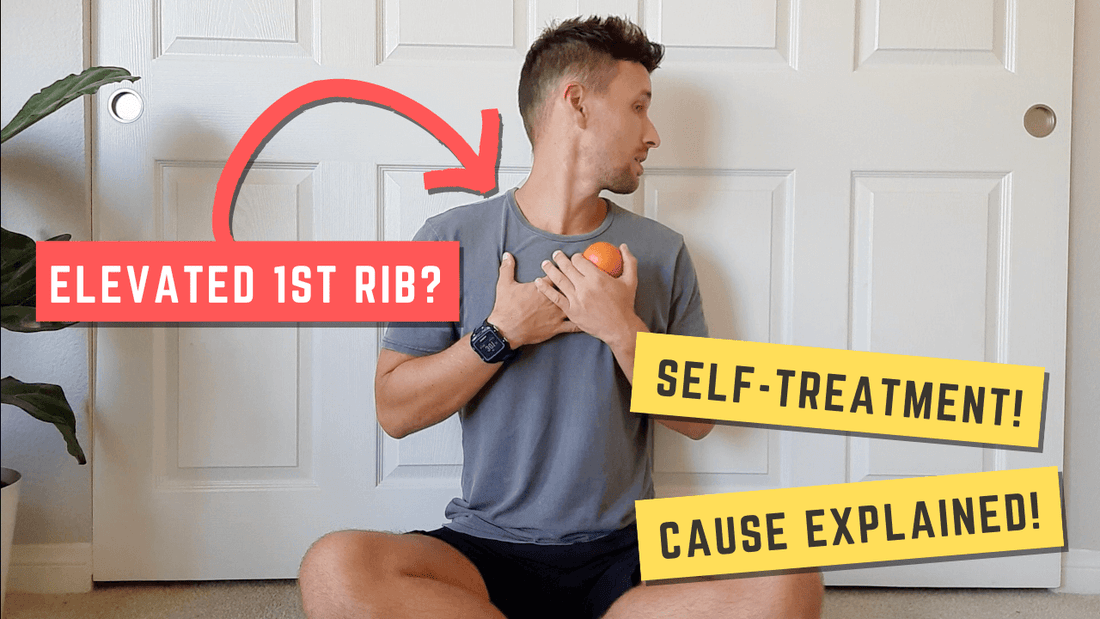
The #1 Cause of an Elevated First Rib (It's Not What You Think) | Your Wellness Nerd
As a Physiotherapist, I see patients every week struggling with nagging neck pain, shoulder stiffness, and even mysterious arm symptoms like tingling and numbness.
Often, they've tried everything—stretching, massage, chiropractic—but the problem keeps coming back.
What if I told you the root cause of this pain is often a tiny, dysfunctional bone at the top of your ribcage: the first rib. And, that the most common belief about it being "elevated" might be completely backwards?
In this guide, I'm going to challenge that conventional wisdom and give you a powerful, self-treatment exercise you can do at home with a tennis ball to find immediate relief.
Key Takeaways:
- The Real Problem: A "stuck" first rib is a major hidden cause of neck pain, shoulder dysfunction, and Thoracic Outlet Syndrome.
- The Big Misconception: The rib isn't always "elevated." It's more often depressed and stuck due to poor posture.
- The Simple Fix: You can often restore normal motion in minutes with a targeted mobilisation using a tennis or lacrosse ball.
What is the First Rib and Why Does It Matter?
Your first rib is a small, C-shaped bone that sits at the very top of your rib cage, tucked up under your collarbone at the base of your neck. It's a crucial anchor point for several neck muscles and forms a protective tunnel—the thoracic outlet—for the nerves and blood vessels that travel to your arm.
When this rib loses its normal mobility and becomes "stuck," it can:
- Impinge nerves, potentially causing pain, tingling, or numbness down the arm (classic Thoracic Outlet Syndrome symptoms).
- Restrict neck rotation and side-bending.
- Limit overhead shoulder motion.
- Cause protective muscle "knots" in your upper traps as they try to stabilise the dysfunctional joint.
The "Elevated First Rib" Myth: A New Perspective from the Clinic
The traditional medical narrative blames an "elevated" first rib, often caused by tight scalene or upper trap muscles pulling it upward. While this can happen, I find it's not the most common scenario in clinical practice.
Think about our modern postures: hours at a computer, on our phones, or driving. This leads to a forward-head, dropped-shoulder position. In this posture, the weight of your arm and shoulder girdle is constantly pulling down on the first rib.
Over time, this persistent downward and forward tension doesn't pull the rib up—it asks your body to adaptively stiffen to compensate, leaving it depressed and stuck.
This isn't just semantics. This perspective directly informs the most effective long-term solution: not just stretching the "tight" muscles, but mobilizing the stuck rib and correcting the poor posture that caused it.
How to Self-Treat Your First Rib Dysfunction
This simple exercise uses a tennis or lacrosse ball to apply direct pressure to the stiff joint, helping to "shear" it free and restore normal motion. You'll know it's working when you feel an immediate improvement in your neck and shoulder movement.
First Rib Mobilisation with a Tennis Ball
What you need: A tennis ball or lacrosse ball. A wall to lean on.
Step 1: Find Your Baseline
Before you start, test your movement:
- Slowly turn your head to the left and right. Does one side feel stiff, pinched, or blocked?
- Lift the arm on your stiff side straight up. Does it feel restricted or is there a noticeable gap between your arm and ear?
Step 2: Locate the First Rib
Feel for the prominent bump at the base of your neck (the C7 vertebra). Just below that is the first thoracic vertebra (T1). Your first rib attaches to the side of T1. Place the ball on this spot, just off your spine, and roll it slightly outward toward the top of your shoulder. You'll know you've found it when you feel a distinct, positive tenderness or stiffness.
Step 3: Apply Pressure and Mobilise
Lean against the wall (or lie on the floor) to apply pressure through the ball. You don't need to roll around; just let the ball sink into the stiff spot.
- Basic Version: Hold the pressure for 60-90 seconds, taking deep breaths and consciously trying to relax the area.
- Advanced Version: While maintaining pressure, slowly raise and lower the arm on the same side. This "shears" the joint free as it moves. You'll likely feel the arm's range of motion increase with each repetition.
Step 4: Re-test and Reassess
Get up from the ball and immediately re-test the movements from Step 1. Most people experience:
- Easier, fuller neck rotation.
- A smoother and higher overhead shoulder motion.
- A noticeable reduction in that "pinching" or "blocking" sensation.
Related: How to Self-Diagnose and Treat Neck-Related Headaches
Preventing First Rib Dysfunction from Returning
Fixing the rib is only half the battle. To stop it from seizing up again, you must address the root cause: your posture.
- Be Aware of "Screen Posture": Set reminders to check your posture. Is your head forward? Are your shoulders slumped and rolled inward?
- Support Your Shoulders: When sitting, consciously draw your shoulder blades back and down slightly, as if you're gently tucking them into your back pockets. This helps unload the first rib.
- Take Frequent Breaks: Every 30 minutes, stand up, reach your arms overhead, and perform a few chin retractions (gently pulling your head straight back without tilting it).
Frequently Asked Questions
How often should I do this first rib mobilisation?
You can do it daily if you're in acute pain. Once the stiffness and symptoms subside, 2-3 times a week for maintenance is often sufficient. Listen to your body.
What's the difference between an elevated and a depressed first rib?
Functionally, both result in a "stuck" rib that causes similar symptoms. The key difference is the direction of the dysfunction. The "depressed" model more accurately reflects the postural strains of modern life, where gravity and poor posture pull the rib down, not up.
I felt a sharp nerve pain during the exercise. What should I do?
Respect it. You may be directly compressing a nerve. Adjust the ball's position slightly, or use less pressure. If sharp pain persists, consult a healthcare professional for a proper assessment.
Can this really help with Thoracic Outlet Syndrome (TOS)?
Absolutely. A stiff first rib is a primary mechanical cause of neurogenic and vascular TOS. By restoring normal rib motion, you decompress the nerves and blood vessels running through the thoracic outlet, which can significantly reduce or eliminate symptoms.
Conclusion: A New Way to Solve Old Pain
By understanding that first rib dysfunction is often a problem of a depressed and stuck rib—not just an elevated one—you can target the real root cause. Combining the powerful tennis ball mobilisation with conscious postural correction gives you a complete strategy not just for temporary relief, but for lasting freedom from neck and shoulder pain.
If this new perspective helped you, please let me know in the comments on the YouTube video. Sharing your experience helps others find this missing piece to their pain puzzle.
- Grant
If you genuinely found this video helpful please consider leaving a SUPER THANKS donation on the video. Also, please consider subscribing to the Your Wellness Nerd YouTube channel for more helpful information.
Need Personalised Guidance?
If you'd like help trying to uncover the underlying cause of your pain or dysfunction, consider booking an online Telehealth consultation with Grant here!

